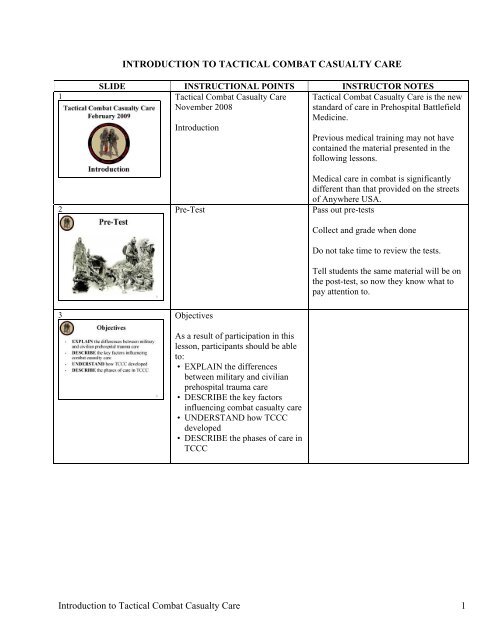INTRODUCTION TO TACTICAL COMBAT CASUALTY CARE - NAEMT
INTRODUCTION TO TACTICAL COMBAT CASUALTY CARE - NAEMT
INTRODUCTION TO TACTICAL COMBAT CASUALTY CARE - NAEMT
Create successful ePaper yourself
Turn your PDF publications into a flip-book with our unique Google optimized e-Paper software.
<strong>INTRODUCTION</strong> <strong>TO</strong> <strong>TACTICAL</strong> <strong>COMBAT</strong> <strong>CASUALTY</strong> <strong>CARE</strong><br />
SLIDE INSTRUCTIONAL POINTS INSTRUC<strong>TO</strong>R NOTES<br />
1 Tactical Combat Casualty Care<br />
November 2008<br />
Tactical Combat Casualty Care is the new<br />
standard of care in Prehospital Battlefield<br />
Medicine.<br />
Introduction<br />
Previous medical training may not have<br />
contained the material presented in the<br />
following lessons.<br />
Medical care in combat is significantly<br />
different than that provided on the streets<br />
of Anywhere USA.<br />
2 Pre-Test Pass out pre-tests<br />
3 Objectives<br />
As a result of participation in this<br />
lesson, participants should be able<br />
to:<br />
• EXPLAIN the differences<br />
between military and civilian<br />
prehospital trauma care<br />
• DESCRIBE the key factors<br />
influencing combat casualty care<br />
• UNDERSTAND how TCCC<br />
developed<br />
• DESCRIBE the phases of care in<br />
TCCC<br />
Collect and grade when done<br />
Do not take time to review the tests.<br />
Tell students the same material will be on<br />
the post-test, so now they know what to<br />
pay attention to.<br />
Introduction to Tactical Combat Casualty Care 1
SLIDE INSTRUCTIONAL POINTS INSTRUC<strong>TO</strong>R NOTES<br />
4 Comparison of Statistics for Battle<br />
Casualties, 1941-2005<br />
TCCC has been one of the big<br />
developments in the GWOT.<br />
The most important measure is how well<br />
TCCC does in helping to keep our<br />
wounded warriors alive to come home to<br />
their families.<br />
This study by Army Trauma Surgeon<br />
John Holcomb documents that we are<br />
now doing that better than ever before.<br />
5 Why Are We Doing Better in<br />
Casualty Survival?<br />
• Improved Personal Protective<br />
Equipment<br />
• Tactical Combat Casualty Care<br />
• Faster evacuation time<br />
• Better trained medics<br />
COL Holcomb and his co-authors list<br />
TCCC as one of the major reasons for that<br />
success.<br />
Also kudos to the rest of the chain of care,<br />
from the Level II and III hospitals in<br />
theater, the evac crews, the staff at<br />
Landstuhl, all the way back to the staffs at<br />
Walter Reed and Bethesda<br />
6 TCCC This letter is from the Chairman of the<br />
Prehospital Subcommittee of the<br />
American College of Surgeons<br />
Committee on Trauma.<br />
The same trauma experts that have<br />
established ATLS for managing trauma in<br />
the hospital endorses TCCC for battlefield<br />
trauma care.<br />
7 Mabry and McManus<br />
AMEDD Center and School<br />
Major Bob Mabry is the Director of<br />
Academics for Combat Medic Training at<br />
the Army Medical Department Center and<br />
School (2008).<br />
He used to be an 18D Special Forces<br />
medic himself.<br />
LTC John McManus is the Director of<br />
Predeployment Medical Training for the<br />
Army Medical Department Center and<br />
School (2008).<br />
Introduction to Tactical Combat Casualty Care 2
SLIDE INSTRUCTIONAL POINTS INSTRUC<strong>TO</strong>R NOTES<br />
8 Importance of the First Responder<br />
• Up to 90% of all combat deaths<br />
occur before the casualty<br />
reaches a Medical Treatment<br />
Facility (MTF)<br />
• The fate of the injured often lies<br />
in the hands of the one who<br />
provides the first care to the<br />
casualty.<br />
• Corpsman, Medic, or<br />
Pararescueman (PJ)<br />
• Combat Lifesaver or nonmedical<br />
combatant<br />
Prehospital care is the most important<br />
aspect in ensuring the survival of the<br />
casualty.<br />
If the casualty does not arrive alive at the<br />
Forward Surgical Team or the Combat<br />
Support Hospital, then the surgeons’ skill<br />
can’t help.<br />
There may not be any combat medical<br />
personnel available when the casualty<br />
occurs.<br />
Care may need to be initially provided by<br />
the combatant.<br />
The goal of TCCC is to identify and treat<br />
those casualties with preventable causes<br />
of death and keep them alive long enough<br />
to reach the hospital.<br />
9 Differences Between Civilian and<br />
Combat Trauma<br />
• The causes of trauma are<br />
different.<br />
• The setting in which the trauma<br />
occurs is different.<br />
• The individuals caring for the<br />
casualties are different.<br />
• Evacuation time is typically<br />
much longer in the combat<br />
setting.<br />
Civilian trauma and combat trauma are<br />
DIFFERENT in many respects.<br />
10 Epidemiology of civilian trauma This graph shows that civilian trauma is<br />
mostly blunt trauma - primarily from<br />
automobile accidents.<br />
In inner-city areas, there is some<br />
penetrating trauma, (stabbings, shootings)<br />
but these are the exception rather than the<br />
norm.<br />
Because of this, the trauma principles<br />
associated with EMT, PHTLS, ATLS is<br />
focused heavily on blunt trauma.<br />
Introduction to Tactical Combat Casualty Care 3
SLIDE INSTRUCTIONAL POINTS INSTRUC<strong>TO</strong>R NOTES<br />
11 How people die in ground combat The three most common causes of<br />
preventable death on the battlefield are:<br />
• Hemorrhage from extremity<br />
wounds<br />
• Tension pneumothorax<br />
• Airway problems<br />
12 Point of Wounding Care<br />
The three most common causes of<br />
preventable death on the battlefield<br />
are:<br />
• Hemorrhage from extremity<br />
wounds<br />
• Tension pneumothorax<br />
• Airway problems<br />
These are the injuries that we need to<br />
focus on for saving lives in combat.<br />
13 Extremity Hemorrhage Play Video<br />
Here is a classic example of a preventable<br />
cause of death - arterial hemorrhage from<br />
an leg wound in a pig).<br />
If no one controls this type of bleeding in<br />
a casualty, that casualty is going to die<br />
very quickly.<br />
14 Tension Pneumothorax This X-ray show a tension pneumothorax,<br />
which in combat is usually secondary to a<br />
penetrating injury to the chest.<br />
This condition may be quickly fatal if not<br />
identified and treated.<br />
Tension pneumothorax is the SECOND-<br />
LEADING cause of preventable death on<br />
the battlefield.<br />
Introduction to Tactical Combat Casualty Care 4
SLIDE INSTRUCTIONAL POINTS INSTRUC<strong>TO</strong>R NOTES<br />
15 Airway Trauma Deaths from airway trauma are a small<br />
percentage of combat fatalities.<br />
If the casualty is conscious, he will<br />
instinctively protect his own airway.<br />
While this patient has a significant injury<br />
to his airway, he is able to breath on his<br />
own reasonably well if he is sitting up and<br />
leaning forward.<br />
This casualty survived and did well after<br />
reconstructive surgery.<br />
Could you lay this casualty down on a<br />
littler on his back to transport him?<br />
Probably a bad idea - all that blood and<br />
mucus would funnel right into his airway.<br />
16 Civilian Trauma Care Setting If you are injured and taken to a civilian<br />
trauma center, you will be treated by a<br />
skilled team of medical professionals<br />
using the latest technology and working in<br />
a well-lighted, climate-controlled area.<br />
What about trauma that occurs in a<br />
tactical combat setting?<br />
17 Tactical Trauma Care Setting –<br />
Shrapnel Wound in the Hindu Kush<br />
This is a good example of where the<br />
combat corpsmen and medics live and<br />
practice.<br />
This picture was taken at about 10,000<br />
feet altitude in the Hindu Kush mountains<br />
in Afghanistan.<br />
The wound is a shrapnel wound of the<br />
hip.<br />
In this setting, care is much more<br />
difficult.<br />
It is common sense that the management<br />
plan is different here.<br />
TCCC helps to define how it’s different.<br />
Introduction to Tactical Combat Casualty Care 5
SLIDE INSTRUCTIONAL POINTS INSTRUC<strong>TO</strong>R NOTES<br />
18 Factors Influencing Battlefield<br />
Casualty Care<br />
• Hostile fire<br />
• Darkness<br />
• Extreme environments<br />
• Mountain<br />
• Desert<br />
• Limited medical equipment<br />
• Possible prolonged evacuation<br />
time<br />
• Unit’s mission<br />
• Tactical flow<br />
These are the factors that may interfere<br />
with your ability to provide care in the<br />
tactical environment.<br />
Enemy fire- this is the number one factor<br />
that will determine when and how much<br />
care you can provide.<br />
Darkness, terrain, and environmental<br />
factors also will influence your ability to<br />
provide care.<br />
Medical equipment is limited to whatever<br />
is carried in bags and individual first aid<br />
kits.<br />
Evacuation times and platforms are based<br />
primarily on the tactical situation at the<br />
time of the evac. Environmental<br />
conditions and cause delays in evac as<br />
well.<br />
Finally, what’s happening on the mission<br />
will often determine when and how much<br />
care can be provided at a given time.<br />
19 Prior Medical Training<br />
in the Past<br />
• Combat medical training<br />
historically was modeled on<br />
civilian courses<br />
• EMT, PHTLS<br />
• BTLS, ATLS<br />
• Trained to standard of care in<br />
non-tactical (civilian) settings<br />
• Tactical elements not considered<br />
These are the training programs that are<br />
used to teach trauma care in the civilian<br />
community.<br />
They are all EXCELLENT training<br />
programs.<br />
However, they are designed for the<br />
civilian trauma setting - the principles<br />
they reflect often need to be modified for<br />
the tactical setting.<br />
Introduction to Tactical Combat Casualty Care 6
SLIDE INSTRUCTIONAL POINTS INSTRUC<strong>TO</strong>R NOTES<br />
20 Different Trauma Requires<br />
Different Care Strategies<br />
• Common sense, BUT<br />
• Difficult to devise and<br />
implement<br />
• No one group of medical<br />
professionals has all of the skills<br />
and experiences necessary.<br />
• Trauma docs and combat<br />
medical personnel have different<br />
skill sets. Both are needed to<br />
optimize battlefield trauma care<br />
strategies.<br />
• Tourniquets are one striking<br />
example of how battlefield<br />
trauma care has sometimes been<br />
slow to change.<br />
TCCC principles are now determined by<br />
physicians and combat medical personnel<br />
working as a team.<br />
In the past, the failure of these two groups<br />
to communicate well slowed the<br />
implementation of critical trauma care<br />
measures.<br />
We will look at a dramatic example of<br />
this.<br />
21 Tourniquets in WWII<br />
Wolff AMEDD J April 1945<br />
22 Vietnam<br />
“We believe that the strap-andbuckle<br />
tourniquet in common use is<br />
ineffective in most instances under<br />
field conditions…it rarely controls<br />
bleeding no matter how tightly<br />
applied.”<br />
Over 2500 deaths occurred in<br />
Vietnam secondary to hemorrhage<br />
from extremity wounds. These<br />
casualties had no other injuries.<br />
This report was written by an Army<br />
doctor in World War II.<br />
Provided very clear input on tourniquets.<br />
A tourniquet would seem to be a simple<br />
thing to fix.<br />
Now, fast-forward 25 years.<br />
25 years later, we had still not learned the<br />
tourniquet lesson in Vietnam.<br />
2500 preventable deaths from extremity<br />
hemorrhage were the result.<br />
Surely, we would have learned the lesson<br />
after this experience.<br />
Maybe not, fast-forward another 25 years.<br />
23 Tourniquets in U.S Military<br />
Mid-1990s<br />
• Old strap-and-buckle tourniquets<br />
were still being issued.<br />
• Medics and corpsmen were<br />
being trained in courses where<br />
they were taught not to use<br />
them.<br />
Amazingly, by the 1990’s, we were still<br />
making the same mistakes about<br />
tourniquets that we had been in World<br />
War II.<br />
Introduction to Tactical Combat Casualty Care 7
SLIDE INSTRUCTIONAL POINTS INSTRUC<strong>TO</strong>R NOTES<br />
24 SOF Deaths in the GWOT<br />
Holcomb, et al Annals of Surgery<br />
2007<br />
And we paid a price for that when the<br />
GWOT started.<br />
Factors That Might Have Changed<br />
Outcomes (82 Fatalities – 12<br />
Potentially Survivable)<br />
• Hemostatic dressings/direct<br />
pressure (2)<br />
• Tourniquets (3)<br />
• Faster CASEVAC or IV<br />
hemorrhage control (7)<br />
• Surgical airway vs intubation (1)<br />
• Needle thoracostomy (1)<br />
• PRBCs on helos (2)<br />
• Battlefield antibiotics (1)<br />
This paper on Special Ops deaths showed<br />
3 out of 12 potentially preventable deaths<br />
were due to extremity hemorrhage.<br />
Note the makeshift tourniquets used here.<br />
25 Tourniquets – Beekley et al<br />
Journal of Trauma 2008<br />
• 31st CSH in 2004<br />
• 165 casualties with severe<br />
extremity trauma<br />
• 67 with prehospital tourniquets;<br />
98 without<br />
• Seven deaths<br />
• Four of the seven deaths were<br />
potentially preventable had an<br />
adequate prehospital tourniquet<br />
been placed.<br />
26 Tactical Combat Casualty Care in<br />
Special Operations<br />
Military Medicine Supplement<br />
August 1996<br />
We were still losing people to extremity<br />
bleeding in 2004.<br />
Notice the makeshift tourniquets used<br />
here.<br />
At about this point, the military had<br />
started a very strong effort to push<br />
tourniquets forward.<br />
Since this study, preventable deaths from<br />
extremity hemorrhage have now been<br />
minimized.<br />
In the mid-90s, the Special Operations<br />
medical community began looking for<br />
some better answers for combat trauma<br />
and Tactical Combat Casualty Care was<br />
born.<br />
Introduction to Tactical Combat Casualty Care 8
SLIDE INSTRUCTIONAL POINTS INSTRUC<strong>TO</strong>R NOTES<br />
27 TCCC<br />
• Originally a Special Operations<br />
research effort<br />
• Trauma management plans that<br />
take into account the unique<br />
challenges faced by combat<br />
medical personnel<br />
• Now used throughout U.S.<br />
military and by most allied<br />
countries<br />
• TCCC has helped U.S. combat<br />
forces to achieve the highest<br />
casualty survival rate in history.<br />
Although TCCC started in Special Ops, it<br />
is now used by all services in the U.S.<br />
military, conventional as well as Special<br />
Ops.<br />
It has proved dramatically successful in<br />
the Global War on Terrorism.<br />
TCCC has been a major factor in U.S.<br />
forces having the highest casualty<br />
survival rate in our history.<br />
28 Three Objectives of TCCC<br />
• Treat the casualty<br />
• Prevent additional casualties<br />
• Complete the mission<br />
The ongoing mission does not stop just<br />
because there is a casualty.<br />
The 3 objectives of TCCC are to provide<br />
lifesaving care to the injured combatant,<br />
to limit the risk of further casualties, and<br />
to help the unit achieve mission success.<br />
29 TCCC Guidelines 1996<br />
• Tourniquets<br />
• Aggressive needle thoracostomy<br />
• Nasopharyngeal airways<br />
• Surgical airways for<br />
maxillofacial trauma<br />
• Tactically appropriate fluid<br />
resuscitation<br />
• Battlefield antibiotics<br />
• Improved battlefield analgesia<br />
• Combine good tactics and good<br />
medicine<br />
• Scenario-based training<br />
• Combat medic input to<br />
guidelines<br />
Here were the principles of TCCC as they<br />
were originally published in 1996.<br />
Read the guidelines.<br />
There had to be a way to keep these<br />
guidelines updated.<br />
Introduction to Tactical Combat Casualty Care 9
SLIDE INSTRUCTIONAL POINTS INSTRUC<strong>TO</strong>R NOTES<br />
30 Committee on Tactical Combat<br />
Casualty Care<br />
• Updates TCCC guidelines as<br />
needed<br />
• Originally at Naval Operational<br />
Medicine Institute (NOMI)<br />
• Now at the Defense Health<br />
Board<br />
• Members from all services and<br />
civilian sector<br />
• Trauma Surgery, Emergency<br />
Medicine, Critical Care,<br />
operational physicians; medical<br />
educators; combat medics,<br />
corpsmen, and PJs<br />
•<br />
In 2001, the Committee on TCCC was<br />
started to keep the TCCC guidelines up to<br />
date.<br />
Note that many medical specialties and<br />
combat medical personnel are all at the<br />
table.<br />
31 TCCC Updates 2003 and 2006<br />
• HemCon and QuikClot<br />
• Intraosseous infusion devices<br />
• Combat Pill Pack<br />
• Hypotensive resuscitation<br />
with Hextend<br />
• Fentanyl lozenges<br />
• Moxifloxacin<br />
• Hypothermia prevention<br />
• Management of wounded hostile<br />
combatants<br />
*Endorsed by ACS COT and<br />
<strong>NAEMT</strong><br />
These are changes in the TCCC<br />
guidelines that were made by the<br />
CoTCCC in 2003 and 2006.<br />
Note that the updated guidelines are now<br />
published with each new version of the<br />
Military Edition of Prehospital Trauma<br />
Life Support Manual.<br />
The recommendations made in this<br />
manual have the endorsement of the<br />
American College of Surgeons<br />
Committee on Trauma and the National<br />
Association of EMTs.<br />
32 Timing Is Everything<br />
• Casualty scenarios in combat<br />
usually entail both a medical<br />
problem as well as a tactical<br />
problem.<br />
• We want the best possible<br />
outcome for both the casualty<br />
and the mission.<br />
• Good medicine can sometimes<br />
be bad tactics; bad tactics can get<br />
everyone killed or cause the<br />
mission to fail<br />
• Doing the RIGHT THING at the<br />
RIGHT TIME is critical<br />
Most battlefield casualty scenarios<br />
involve making both medical and tactical<br />
decisions very rapidly.<br />
Remember the enemy still wants to kill<br />
you.<br />
The combat environment does not take a<br />
“time-out” just because you have a<br />
casualty.<br />
Introduction to Tactical Combat Casualty Care 10
SLIDE INSTRUCTIONAL POINTS INSTRUC<strong>TO</strong>R NOTES<br />
33 TCCC Phases of Care<br />
• TCCC divides care into 3 phases<br />
based on the tactical situation.<br />
• During the gunfight, attention is<br />
focused primarily on eliminating<br />
the threat.<br />
• As the threat decreases,<br />
increasing focus is applied to<br />
providing the best possible<br />
medical care for the casualties.<br />
Doing the RIGHT thing at the WRONG<br />
time can get you and your teammates<br />
killed.<br />
34 Phases of Care in TCCC<br />
• Care Under Fire<br />
• Tactical Field Care<br />
• Tactical Evacuation Care<br />
These are our 3 phases of care in TCCC.<br />
Next we’ll define these three phases of<br />
care.<br />
The picture is an FA-18 flying by Mt.<br />
Fuji.<br />
35 Care Under Fire<br />
Care under fire is the care rendered<br />
by the first responder or combatant<br />
at the scene of the injury while he<br />
and the casualty are still under<br />
effective hostile fire. Available<br />
medical equipment is limited to that<br />
carried by the individual or by the<br />
medical provider in his or her aid<br />
bag.<br />
36 Tactical Field Care<br />
Tactical Field Care is the care<br />
rendered by the first responder or<br />
combatant once he and the casualty<br />
are no longer under effective hostile<br />
fire. It also applies to situations in<br />
which an injury has occurred, but<br />
there has been no hostile fire.<br />
Available medical equipment is still<br />
limited to that carried into the field<br />
by unit personnel. Time to<br />
evacuation to a medical treatment<br />
facility may vary considerably.<br />
The key sentence in this statement is that<br />
the first responder and the combatant are<br />
still under effective hostile fire.<br />
The tactical situation has now changed.<br />
The first responder and the casualty are<br />
now no longer under effective hostile fire.<br />
This allows more time and a little more<br />
safety, to be able to perform more medical<br />
care.<br />
Remember – effective hostile fire could<br />
resume at any time.<br />
Introduction to Tactical Combat Casualty Care 11
SLIDE INSTRUCTIONAL POINTS INSTRUC<strong>TO</strong>R NOTES<br />
37 Tactical Evacuation Care<br />
Tactical Evacuation Care is similar to<br />
TFC in many respects.<br />
Tactical Evacuation Care is the care<br />
rendered once the casualty has been<br />
picked up by an aircraft, vehicle or<br />
boat. Additional medical personnel<br />
and equipment that may have been<br />
pre-staged should be available in<br />
this phase of casualty management.<br />
However, the extra medical personnel and<br />
equipment being available on the<br />
evacuation asset may enable you to do<br />
some additional care.<br />
The term “Tactical Evacuation”<br />
encompasses both Casualty Evacuation<br />
(CASEVAC) and Medical Evacuation<br />
(MEDEVAC).<br />
More on this later.<br />
38 Summary of Key Points<br />
• Prehospital trauma care in<br />
tactical settings is markedly<br />
different from civilian settings.<br />
• Tactical and environmental<br />
factors have a profound impact<br />
on trauma care rendered on the<br />
battlefield.<br />
• Good medicine can be bad<br />
tactics.<br />
• Approximately 18% of combat<br />
deaths today are potentially<br />
preventable.<br />
• Good first responder care is<br />
critical.<br />
• TCCC will give you the tools<br />
you need!<br />
39 Summary of Key Points<br />
• Three phases of care in TCCC<br />
• Care Under Fire<br />
• Tactical Field Care<br />
• TACEVAC Care<br />
TCCC principles are different than the<br />
civilian training you may have received in<br />
the past.<br />
This improvement in how we approach<br />
the combat casualty has resulted in<br />
significantly lower death rates in combat.<br />
Good battlefield care is paramount to<br />
avoid preventable causes of death.<br />
Summarize key point of each phase.<br />
Introduction to Tactical Combat Casualty Care 12
SLIDE INSTRUCTIONAL POINTS INSTRUC<strong>TO</strong>R NOTES<br />
40 Summary of Key Points<br />
• TCCC – designed for combat<br />
• NOT designed for civilian<br />
trauma settings<br />
• In civilian settings, follow your<br />
EMS policy<br />
TCCC is NOT necessarily the standard of<br />
care in civilian prehospital settings.<br />
In civilian EMS settings, you should<br />
follow the guidance established by your<br />
Emergency Medical Services Director.<br />
41 Questions?<br />
Introduction to Tactical Combat Casualty Care 13






